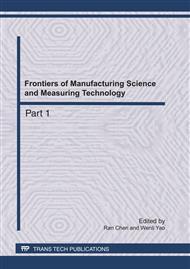p.1072
p.1079
p.1084
p.1089
p.1093
p.1099
p.1104
p.1110
p.1114
Investigations on Ni-Mo Alloy Microstructure with Mo Atom Content
Abstract:
Using X-ray diffraction (XRD), scanning electron microscope (SEM) and transmission electron microscope (TEM) to describe the relationship between Mo content and the amorphous content in deposites from the effects of the molybdate concentration on microstructure, phase content and morphology of the deposits. It is found when the Mo content is low to 18at.%, the deposits are composed of nanocrystalline main phases and the grain size is below 10nm with tiny particle at the basement surface. When Mo in 18~33at.%, the deposits are composed of amorphous phase up to more than 60wt.% proportion, and the grain size of the nanocrystalline existing in the deposits is stability of 3~10nm with tiny particle and well-distribution of the basement surface. When Mo content is exceeding 33at.%, the deposits performance is of the crystalline properties with more crystal defects in the coating.
Info:
Periodical:
Pages:
1093-1098
Citation:
Online since:
May 2011
Authors:
Keywords:
Price:
Сopyright:
© 2011 Trans Tech Publications Ltd. All Rights Reserved
Share:
Citation:


